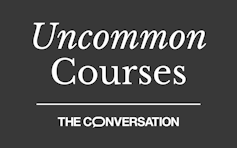

Uncommon Courses is an occasional series from The Conversation U.S. highlighting unconventional approaches to teaching.
Title of course:
Alcohol in American Literature
What prompted the idea for the course?
I got the idea for the course when I was writing a chapter on the temperance movement in American literature for my doctoral dissertation. I ended up reading a lot of fiction and poetry about alcohol and the anti-alcohol movement. I thought it would be fun to teach a class that surveyed American literature through a booze-themed lens.
Since alcohol affects and disables people regardless of gender, sexual orientation, race, ethnicity or class, it is easy to find literature about the impact of alcohol from many points of view.
What does the course explore?
I pair my course with a medical doctor who teaches a course on the biology of addiction. In the biology course, students learn about the biological and physiological effects of diseases of addiction, substance use and abuse, dependency and recovery.
The core curriculum at John Carroll University requires students to take paired courses from different departments that are linked together. A colleague who teaches biology courses approached me about linking my alcohol class to her addiction class. Students must take both of our courses during the same semester. The combined courses give students both a scientific and literary view of addiction.
Students read fiction, poetry and drama about many aspects of alcohol and other addictive substances: celebrating them, struggling with them, even prohibiting and regulating them. Students compare the literary representations of substance and alcohol abuse with medical descriptions and impacts. For example, when my class reads Kristen Roupenian’s viral short story “Cat Person,” we talk about the role of alcohol in reducing inhibition when casually dating.
What’s a critical lesson from the course?
My goal is for students to come to a better understanding of how alcohol influences literature. They learn how some writers portray the way alcoholism further marginalizes minorities. For example, characters in Sherman Alexie’s “The Lone Ranger and Tonto Fistfight in Heaven” are enrolled members of the Spokane Tribe of Indians. They live on the reservation and have great difficulty finding or keeping a job. Many characters suffer from intergenerational trauma, poverty and a pervasive addiction to alcohol.
For their final project, students must pitch a movie that offers a compelling plot with relatable characters. The storyline must be backed up by a deep understanding of the science of disease and addiction.
What materials does the course feature?
• “Night of the Living Rez,” by Morgan Talty, explores addiction and poverty among the Penobscot Nation.
• “The Sun Also Rises,” by Ernest Hemingway, is a classic novel set in 1920s Paris about a set of heavy-drinking American ex-pats dealing with the trauma of World War I.
• We visit Karamu House, the U.S.’s oldest continuing African American theater, to watch a performance of “Clyde’s,” a popular play by Lynn Nottage that is set in a truck stop sandwich shop that employs the recently incarcerated.
What will the course prepare students to do?
Students can be better advocates for their own personal health, and the health of others, if they understand how addictive substances affect their minds and bodies. Pre-health students in particular get a general introduction to medical issues related to addiction and how American authors have long portrayed booze.
For example, Frances Watkins Harper’s “The Two Offers,” written in the 1850s, is believed to be the first short story ever published by an African American woman. It is a temperance story that encourages young women not to marry a drunkard, highlighting the antebellum Black community’s concerns about sobriety and domestic well-being, in addition to freedom.
The course hones students’ critical reading and writing skills while challenging them to think about the role of alcohol, substance abuse, sobriety and recovery in their lives and in American culture.
Debra J. Rosenthal does not work for, consult, own shares in or receive funding from any company or organisation that would benefit from this article, and has disclosed no relevant affiliations beyond their academic appointment.
This article was originally published on The Conversation. Read the original article.







